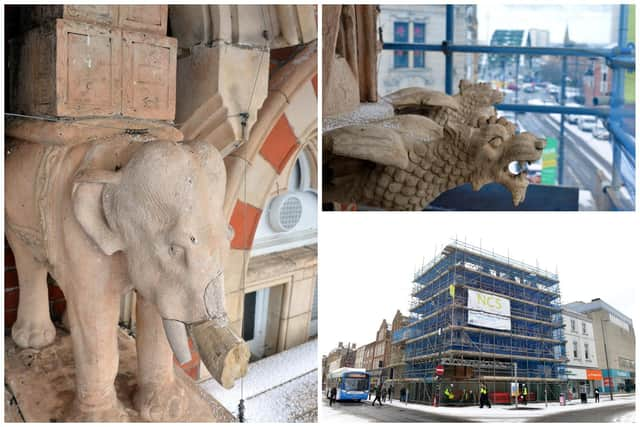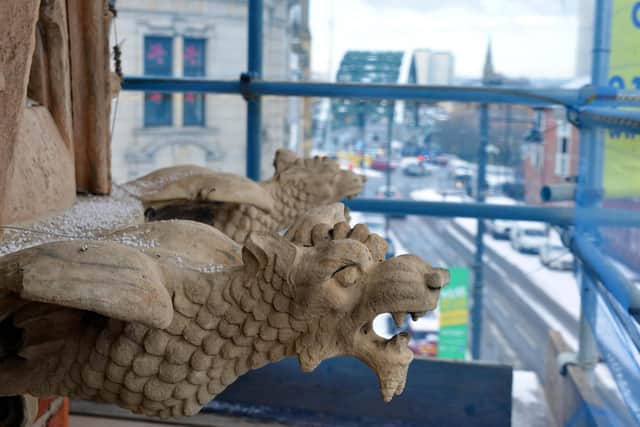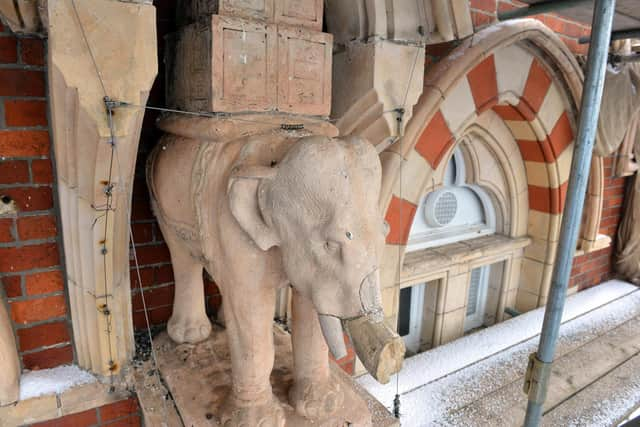Sunderland's Elephant Tearooms: Up close with the building's amazing Hindu Gothic detail as restoration work progresses
and live on Freeview channel 276
The Elephant Tearooms is a grand example of Hindu Gothic style and is testament to Sunderland’s wealth in the late nineteenth century.
Located at the corner of High Street West and Fawcett Street, it opened to the public in 1875 as a grocer’s shop and tea warehouse for Grimshaw & Son with an incredible amount of detail in its construction, from dragon gargoyles which guard over this gateway to the city centre to three stone elephants carrying tea boxes, which still bear the original carvings.
Advertisement
Hide AdAdvertisement
Hide AdNow, its intricate features are being brought back to life as part of a major restoration project.


The painstaking restoration is gathering pace with skilled stonemasonry repairs on its terracotta features, new trunks being crafted for the elephants and new shop fronts to replicate the originals and replace the drab 1970s versions which have stood at ground level for the past few decades.
Part of the wider Heritage Action Zone project, which has proved a great success at other city centre buildings such as Mackie’s Corner and Pop Recs, it will see this handsome building become a landmark the city can be proud of once again.
The external restoration project, which is due for completion in August, is being supported with a total of £720,000 funded by Sunderland City Council, Historic England and the Department for Levelling Up, Housing & Communities (DLUHC) through the Future High Street Fund and Heritage Action Zone (HAZ) projects.
Advertisement
Hide AdAdvertisement
Hide AdThe Grade II-Listed building was designed by architect Frank Caws who was known for his flamboyant style. His work can also be seen further down Fawcett Street in Corder House and Sydenham House.


Mark Taylor, Principal Conservation Officer at the Council, said: “Like most of Fawcett Street, if you look up this is a beautiful building. Frank Caws was known as somewhat of a rogue architect because of his extravagant and unusual style.
"This was built during an age of great prosperity in the city and from the 1870s to 1910 it saw the creation of some great buildings, such as the Empire, The Dun Cow and The Peacock which are in the Edwardian Baroque style. The tearooms are particularly unusual because of its Hindu Gothic features.”
There’s been much interest in the restoration project and Mark says it’s great to see so many of the city’s old buildings being brought back to life.
Advertisement
Hide AdAdvertisement
Hide Ad"We’ve had nothing but positive feedback,” he said. “Opposite you have Mackie’s Corner which is a great example of a local building being taken over by a local family, which now houses local, independent traders providing a great local service. It sends a strong message on how high streets can be revitalised.


“The key to regeneration is combining heritage regeneration with new developments.”
The restoration project is comprised of two buildings: the tearooms and a neighbouring Georgian townhouse which over the years became one unit.
As part of the scheme, the original Georgian shop front and the tearoom’s original Victorian shop front are being replicated after being torn down years ago.
Advertisement
Hide AdAdvertisement
Hide AdBoth will house commercial units on the ground floor, with the upper floors being used for mixed commercial use.